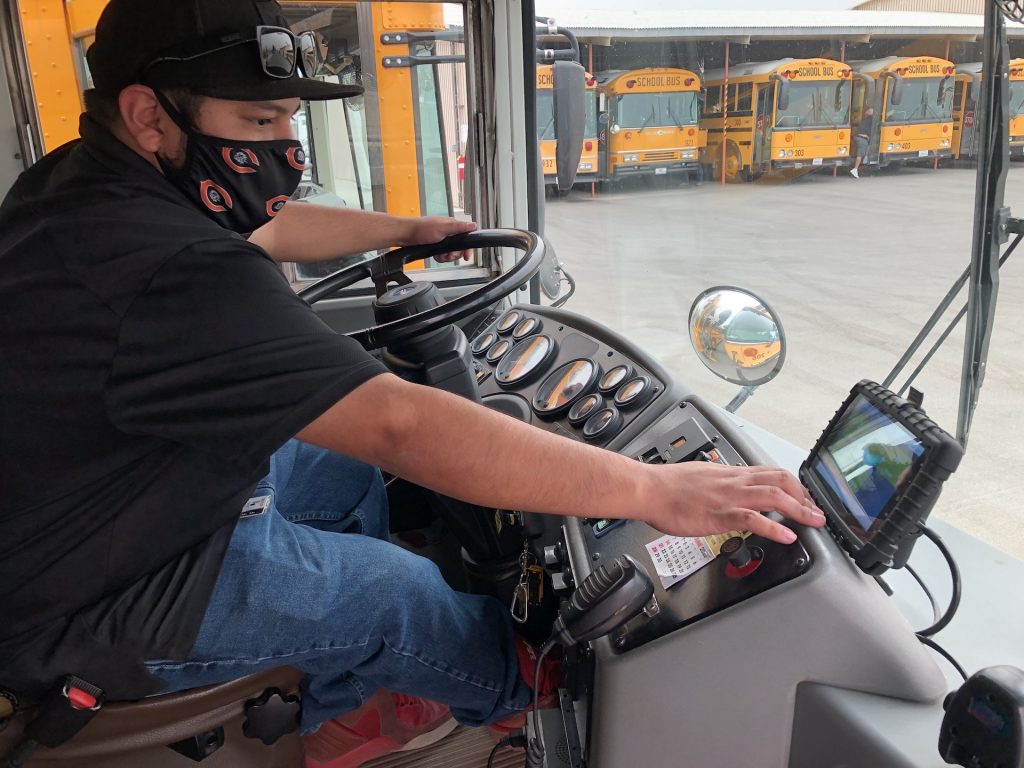In the U.S. there is a chip shortage. More specifically, electronic chip procurement and sourcing has moved offshore. Recently, this has been problematic during COVID-19, when the offshore supply became strangulated, rippling forward to those who depended upon that supply.
This is the case for many types of electronics, from components of automobiles to cell phones, laptops, and tablets. School districts could feel the effect in procuring and updating tablets used for navigation and other purposes in transiting their daily routes — or could they?
Confidence in the Short Term
While many electronics manufacturers and technology developers are dealing with a shortage of chips and electronic components, not all tablet manufacturers are feeling the strain. Tyler Technologies, for example, provides student transportation management solutions with technology that includes software and tablets that buses use.
“We partner with an industry-leading tablet vendor to produce our Tyler Drive devices,” said CJ Vose, senior director of sales for the company. “By having such a stable hardware supplier, we have not seen any disruption in our ability to produce or provide tablets for our clients. If issues do arise, we work directly with our clients to provide the technical support needed.”
Others that supply tablets to schools have felt the effects of the chip shortage but remain optimistic. The threat of supply chain strain may be more concerning to other industries outside tablets manufactured for school transportation routing, tracking, and navigation.
“Zonar has not experienced supply chain disruptions with our current tablets,” said Kenneth Bean, vice president of managing operations for Zonar. “Overall, the industry is seeing improvements in semiconductor supply, and shortages tend to be very specific to semiconductor product lines within a manufacturer IC product line, none of which are ours.”
However, others beg to differ and are not confident that the chip supply is in good order. Some improvements have been made. But the problem still exists. Risk mitigation is on their radar, and they are taking steps to safeguard against any ripples or setbacks that could come their way.
“Despite some lead time improvements compared to the prior 12 to 18 months, longer than normal lead times persist, not only for tablets, but for most electronic equipment,” said Curtis Lee Smith, vice president of operations for PTLW Video, part of Safe Fleet. “Not only are LCD’s impacted (fundamental to tablets) but chips, microchips, DSP’s and many other key components have long lead times. These conditions have been heightened by regional COVID-19 public health regulations resulting in labor shutdowns in many countries key to the North American supply chain.”
The Bigger Picture
A November 2022 joint report by the Boston Consulting Group (BCG) and the Semiconductor Industry Association (SIA), entitled “The Growing Challenge of Semiconductor Design Leadership,” stated that there are indeed challenges with design leadership and how the U.S. must successfully approach the design problem. It’s not over and it could get worse.
The report states: “In recent years, however, the U.S. share of design-related revenues has begun to show signs of a decline, dropping from over 50 percent in 2015 to 46 percent in 2020. Other regions, especially South Korea and China, are seeing local growth in their design capabilities. Our analysis shows that at the current trajectory (that is, if planners take no action), the U.S. share could fall to 36 percent by the end of this decade as other regions capture a larger share of future growth.”
President Biden’s executive order 14017, which directs “a whole-of-government approach to assessing vulnerabilities in, and strengthening the resilience of, critical supply chains and mitigating the effects of a supply chain shortfall for many commodities, which includes electronics for manufacturing.” Stemming from that effort. The federal government set up a supply chain disruption task force which is an outgrowth of this executive order. The task force is dead set on what they call “directing a whole-of-government approach” in the assessment of supply chain vulnerabilities and serving to strengthen the overall resilience of critical supply chains, which includes electronic chips for a wide range of uses in many industries.
One of the points brought out in the joint report by BCG and SIAA is that design and R&D investment is greatly needed. “As chips have grown more complex, development costs have risen, especially for chips made on leading-edge manufacturing nodes,” the report states. “Today, the U.S. private sector invests more in design R&D than any other region’s private sector does, but governments around the world offer significant incentives to attract advanced design, and the U.S. risks falling behind. In addition, the relative level of public support for R&D in the U.S. lags that of other regions.”
This is more reason for electronic manufacturers and product suppliers to not wait for the silver-bullet solution from government to resolve any supply chain shortage but to consider what they can do to further mitigate any risk should it be problematic.
Risk Mitigation?

The limited availability and uncertainty of future availability undoubtedly poses long term risk. Many within industry and in government are taking action to mitigate the risk. However, another facet of the issue for tablets and electronic gear specific to school transportation is if tablets can’t be produced to meet order demands, are tablet manufacturers taking action to work around the problem? Could they perhaps use different software that might be more compatible with available chips or processors?
Some suppliers stockpiled orders or key components or their products to ensure a seamless manufacture of their products and meet imminent demand. This appears to be a short-term solution to a problem that may, or may not, be a long-term problem.
“Safe Fleet made the commitment to invest in inventory early,” said Smith. “Once constraints became more apparent, we placed orders for key components and worked to expedite inventory to ensure continuity of supply. As a result, we are currently well positioned to support the needs of our customers.”
But he added Safe Fleet knows that this may not be enough to meet demand after their orders are used up. They have put effort into ways to mitigate the risk via alternative methods.
“As part of our risk mitigation strategy, Safe Fleet is and has been looking at other alternatives to ensure we mitigate, to the greatest extent possible, any impact on our overall fulfillment going forward, tablets included,” said Smith.
He went on to say that Safe Fleet isn’t so focused on changing software that alters the performance or characteristics of the transportation solution’s performance. Instead, he said that the crux of the problem is in the availability of hardware. One way to mitigate future problems is to focus on modifying firmware, the computer software that provides low-level control for a device’s specific hardware. This may allow them to continue to use existing hardware without relying on new orders for new and advanced hardware.
“The supply chain shortages are really all about the hardware,” said Smith. “Regardless of current or modified software or firmware, what matters is that we have a piece of hardware onto which we can load that code. We are focused on alternatives to key hardware components identified in our risk assessments. These alternatives may potentially require a change in our firmware. Where that is necessary, we will take that step.”
Related: As Supply Chains Crawl, Vendor-Customer Relationships Pick Up Pace
Related: The Squeeze Felt Around the World
Related: A Crack in the Supply Chain
















